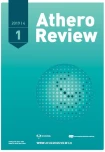Lysosomal acid lipase deficiency in differential diagnosis of familial hypercholesterolemia
Authors:
Zuzana Urbanová 1; Věra Malinová 2
Authors‘ workplace:
Klinika dětského a dorostového lékařství, 1. LF UK a VFN v Praze
1; Centrum preventivní kardiologie III. interní kliniky 1. LF UK a VFN v Praze
2
Published in:
AtheroRev 2019; 4(1): 30-34
Category:
Reviews
Overview
Lysosomal acid lipase deficiency (LAL-D) is a rare autosomal recessive lysosomal storage disease caused by deleterious mutations in the LIPAgene. Occurrence is worldwide estimated to be 1 : 130 000 to 1 : 300 000 live births. Patients presenting in infancy have the most rapidly progressive disease, developing signs and symptoms in the first weeks of life and rarely surviving beyond 6 months of age (Wolman disease). Children and adults typically present with some combination of dyslipidemia, hepatomegaly, elevated transaminases, and microvesicular hepatosteatosis on biopsy – cholesterylester storage disease (CESD). Liver damage with progression to fibrosis, cirrhosis and liver failure occurs in a large proportion of patients. Elevated low-density lipoprotein cholesterol levels and decreased high-density lipoprotein cholesterol levels are common features, and cardiovascular disease may manifest as early as childhood. The lipid profile is very similar as we can see in familial hypercholesterolemia, so it is not surprising that LAL-D is under-recognized in clinical practice. This article provides practical guidance to lipidologists, on how to recognize individuals with this disease and, current management options are reviewed in light of the development of enzyme replacement therapy with sebelipase alfa, a recombinant human lysosomal acid lipase enzyme.
Keywords:
combination therapy – hepatomegaly – lysosomal acid lipase deficiency – Wolman disease
Sources
- Elleder M, Poupětová H, Ledvinová J et al. Deficit kyselé (lyzozomální) lipázy: přehled českých pacientů. Čas Lék česk 1999; 138(23): 719–724.
- Elleder M, Chlumska A, Hyanek J et al. Subclinical course of cholesteryl ester storage disease in an adult with hypercholesterolemia, accelerated atherosclerosis, and liver cancer. J Hepatol 2000; 32(3): 528–534.
- Hulkova H, Elleder M. Distinctive histopathological features that support a diagnosis of cholesterol ester storage disease in liver biopsy specimens. Histopathology 2012; 60(7): 1107–1113. Dostupné z DOI: <http://dx.doi.org/10.1111/j.1365–2559.2011.04164.x>.
- Reiner Ž, Guardamagna O, Nair D et al. Lysosomal acid lipase deficiency – An under-recognized cause of dyslipidaemia and liver dysfunction. Atherosclerosis 2014; 235(1): 21–30. Dostupné z DOI: <http://dx.doi.org/10.1016/j.atherosclerosis.2014.04.003>.
- Fouchier SW, Defesche JC. Lysosomal acid lipase A and the hypercholesterolaemic phenotype. Curr Opin Lipidol 2013; 24 (4):332–338. Dostupné z DOI: <http://dx.doi.org/10.1097/MOL.0b013e328361f6c6>.
- Grabowski GA, Du H, Charnas L. Lysosomal acid lipas e deficiencies: the Wolman disease/cholesteryl ester storage disease spectrum. In: Valle D (ed), Beaudet AL, Vogelstein B et al. The Online Metabolic and Molecular Bases of Inherited Disease. McGraw Hill 2006. Dostupné z DOI: <http://dx.doi.org/10.1036/ommbid.172>.
- Valle D, Beaudet L,Vogelstein B (eds) et al. The Online Metabolic and Molecular Bases of Inherited Disease. McGraw Hill 2006. Dostupné z DOI: <https://ommbid.mhmedical.com>.
- Chatrath H, Keilin S, Attar BM. Cholesterol ester storage disease (CESD) diagnosed in an asymptomatic adult. Dig Dis Sci 2009; 54(1): 168–173. Dostupné z DOI: <http://dx.doi.org/10.1007/s10620–008–0310–2>.
- Malinová V, Honzík T. Lysosomální onemocnění – současné možnosti diagnostiky a terapie Pediatr Praxi 2013; 14(2): 99–103.
- Burton BK, Balwani M, Feillet F et al. A Phase 3 Trial of Sebelipase Alfa in Lysosomal Acid Lipase Deficiency, N Engl J Med 2015; 373(11): 1010–1020. Dostupné z DOI: <http://dx.doi.org/10.1056/NEJMoa1501365>.
- Bernstein DL, Hulkova H, Bialer MG et al. Cholesteryl ester storage disease: review of the findings in 135 reported patients with an underdiagnosed disease. J Hepatol 2013; 58(6): 1230–1243. Dostupné z DOI: <http://dx.doi.org/10.1016/j.jhep.2013.02.014>.
Labels
Angiology Diabetology Internal medicine Cardiology General practitioner for adultsArticle was published in
Athero Review

2019 Issue 1
Most read in this issue
- Nutraceuticals with hypolipidemic effect in clinical practice: a summary statement of the International expert panel of lipidologists prepared by the committee of the Czech society for atherosclerosis
- Lysosomal acid lipase deficiency in differential diagnosis of familial hypercholesterolemia
- Therapy of dyslipidaemia in patient with muscular dystrophy: case report
- Psoriasis as a risk factor for cardiovascular events: case report
